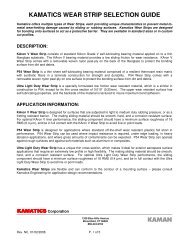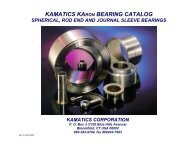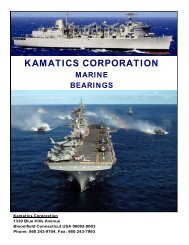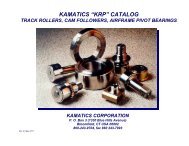Kamatics Karon Design Guide - Kaman Corporation
Kamatics Karon Design Guide - Kaman Corporation
Kamatics Karon Design Guide - Kaman Corporation
Create successful ePaper yourself
Turn your PDF publications into a flip-book with our unique Google optimized e-Paper software.
KAMATICS CORPORATION<br />
be designed but only after careful<br />
consideration to pin bending is given.<br />
Bell-mouths (shallow tapers) machined<br />
into the bore will minimize edge loading<br />
due to large L/D ratios.<br />
Things to consider in the design of a<br />
KAron lined self-lube journal bearing:<br />
• KAron liner material is machineable<br />
using conventional turning, reaming<br />
or honing procedures. Appendix A<br />
explains these techniques. Bearings<br />
can be supplied with thicker liner<br />
material to allow final machining of<br />
the ID after installation.<br />
• Consideration should be given to the<br />
type of installation fit between the<br />
bearing OD and housing. A press fit<br />
will reduce the operating clearance<br />
between the bore and mating shaft,<br />
and if not addressed, may create an<br />
interference with the shaft. Tables 2<br />
& 3 offer housing dimensions for use<br />
with <strong>Karon</strong> journal bearings.<br />
• As in the case of many journal<br />
bearing applications, the bearing<br />
manufacturer supplies only one half<br />
of the bearing system. The end user<br />
supplies the other half (the inner<br />
race) in the form of a bolt, sleeve,<br />
pin, or similar.<br />
• As noted, the user supplies the<br />
mating part and the installation of<br />
this part must be carefully controlled.<br />
The shaft must be accurately aligned<br />
to minimize liner damage during<br />
insertion into the bearing. It should<br />
have a smooth chamfer or radius on<br />
the end that enters the bearing.<br />
Fortunately, <strong>Kamatics</strong> self-lube<br />
liners have a significant advantage<br />
over fabric self-lube liners in that in<br />
the event of localized damage during<br />
shaft installation, the damage<br />
remains local. There are no<br />
interconnecting fibers or weave that<br />
will allow the damage to progress<br />
and propagate under load until loss<br />
6<br />
KAMAN<br />
of liner or jamming of the shaft has<br />
occurred in the bore.<br />
• It is important to select the most<br />
corrosion resistant and hardest<br />
•<br />
material with the smoothest surface<br />
finish possible for the application<br />
under consideration. Consider the<br />
use of hard chrome plate to further<br />
enhance the shaft finish.<br />
The selection of mating materials<br />
can be a difficult decision and in<br />
order not to “over-design”, the<br />
amount of wear and the type and<br />
number of expected operating cycles<br />
should be known.<br />
• Table 4 lists the potential trade-off<br />
relative to life with various mating<br />
shaft hardnesses and surface finishes.<br />
Table 4 displays general “trend” type<br />
of information and should not be<br />
taken as an absolute value. <strong>Kamatics</strong><br />
engineering is available for guidance<br />
if necessary.<br />
3. Spherical Bearings<br />
<strong>Kamatics</strong> <strong>Corporation</strong> has designed and<br />
manufactured self-lubricated spherical<br />
bearings since 1966. The original<br />
<strong>Kamatics</strong> spherical bearing was made<br />
from compacted carbon matrix liners<br />
operating against a chrome oxide coated<br />
and polished surface. This was known<br />
as a “KAcarb” bearing and is still in use<br />
today for applications operating at<br />
temperatures up to 1200°F degrees F<br />
(635°C). Today, as mentioned<br />
previously, <strong>Kamatics</strong> manufactures<br />
spherical bearings with KAron self-lube<br />
liners for temperatures to 400°F (204°C)<br />
and KAtherm for temperatures to 600°F<br />
(315°C). Contact your <strong>Kamatics</strong><br />
representative for further information for<br />
KAtherm and KAcarb applications.







